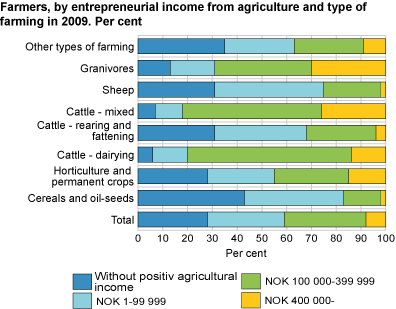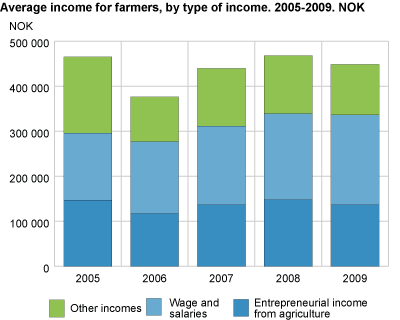Content
Published:
This is an archived release.
Reduction in agricultural income in 2009
On average, Norwegian farmers' entrepreneurial income from agriculture was NOK 136 000 in 2009, down NOK 11 000 from the previous year. Twenty-eight per cent of farmers had no positive income from agriculture, while 8 per cent had NOK 400 000 or more.
Agricultural holdings vary considerably in size, from hobby-like production to holdings with a turnover of more than NOK 1 million. This is the main reason for the considerable variation in entrepreneurial income from agriculture. From 2008 to 2009, the average entrepreneurial income from agriculture for all farmers fell from NOK 147 000 to NOK 136 000. About 32 000 farmers with positive entrepreneurial income from agriculture had an average income of NOK 190 000. In 2009, the income from agriculture amounted to 30 per cent of the gross income for the farmers.
Falling agricultural income in cereals production
For farmers with specialist cereals and oil-seed production, agricultural income fell by 27 per cent from 2008 to 2009, to NOK 62 000. These farmers had the lowest entrepreneurial income from agriculture in 2009, and 43 per cent of them had no positive income from agriculture. In 2008, the corresponding figure was 30 per cent. Only 9 per cent of the farmers with specialist cereals and oil-seed production had agriculture as main source of income. The fall in agricultural income for these is mainly due to the lowest production of cereals since 1994 and increasing prices on commercial fertilizers.
Farmers with productions based on grazing livestock, such as specialist cattle dairying and specialist sheep production, had about the same agricultural income in 2009 as in 2008. The average agricultural income for farmers with cattle dairying was NOK 240 000 and for the sheep farmers NOK 74 000.
The farmers with specialist pig/poultry had their average agricultural income reduced by NOK 41 000 from the previous year, but these farmers still have the highest average agricultural income, with NOK 298 000.
In all counties, except for Hordaland, Sogn og Fjordane and Finnmark, the average agricultural income in 2009 for all farmers was lower than the previous year. In Akershus, Østfold and Vestfold, where specialist cereals and oil-seed production is an important type of farming, the average agricultural income decreased by 26 per cent, 20 per cent and 19 per cent respectively.
28 per cent of farmers had no positive income from agriculture
A total of 9 300 farmers (21 per cent) had negative entrepreneurial income from agriculture in 2009. Average deficit was NOK 89 000. This group includes farmers with small holdings and farmers who had just started farming or were expanding.
A total of 3 200 farmers (7 per cent) have no entrepreneurial income from agriculture in 2009. However, 1 300 of these farmers had a spouse/registered partner who had entrepreneurial income from agriculture. The remaining 1 900 holdings, where neither the farmer nor the spouse/registered partner had entrepreneurial income from agriculture, are assumed to have had hobby-like agriculture that is not considered an industry by the tax authorities.
|
The statistics are based on tax return data and comprise the population of agricultural holdings operated by a natural person. |
|
The person considered responsible for operating an agricultural holding. An agricultural holding includes horticulture and animal husbandry. |
Tables:
- Table 1 Entrepreneurial income from agriculture for holders, by county, agricultural area in use and sex of holder
- Table 2 Entrepreneurial income from agriculture for holders, by type of farming. 2009
- Table 3 Average income for holders, by county, agricultural area in use and sex of holder. NOK
- Table 4 Average income for holders, by type of farming. 2009. NOK
- Table 5 Holders by entrepreneurial income from agriculture as per cent of gross income, by county, agricultural area in use and sex of holder
- Table 6 Holders by entrepreneurial income from agriculture as per cent of gross income, by type of farming. 2009
- Table 7 Average entrepreneurial income from agriculture for holders, by type of farming and county. NOK
Contact
-
Per Amund Aarstad
E-mail: per.amund.aarstad@ssb.no
tel.: (+47) 40 81 13 79
-
Berit Bjørlo
E-mail: berit.bjorlo@ssb.no
tel.: (+47) 40 81 13 76


